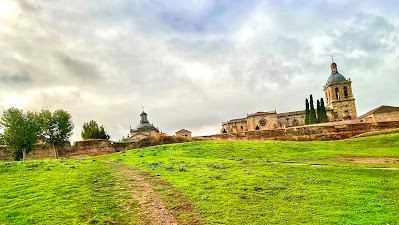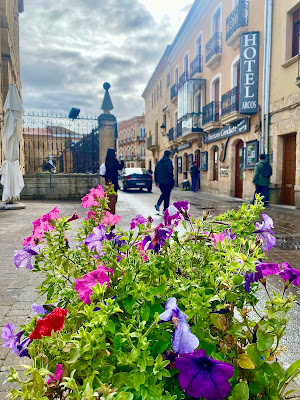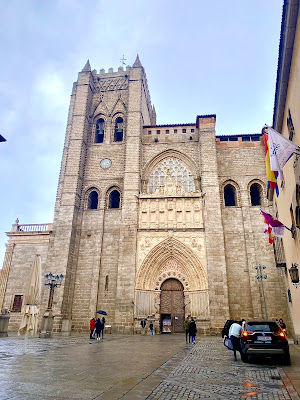Traveling broadens your horizon. It enriches your mind and your spirit. But traveling uses up a lot of your time and treasure. It would be a waste if you missed something on your trip you should’ve seen or experienced. It happened to me several times and I regretted that so much. If you’re planning a trip, I’d like to help you avoid missing out. So, let my blog show you what to look out for. Prepare for your trip by traveling with me through this post. Or you might still be in the praying and dreaming stage. Manifesting your dream into reality starts here!
A
Happy Solo in Ciudad Rodrigo and Avila
Adeus
Portugal, Hola España!
After four
blessed-by-sunshine days in Portugal, we were off to Spain. Our itinerary was a
whole day drive from Fátima to Madrid. The trip was made interesting by visits
to two historic walled cities of Spain.
 |
| Walled City of Ciudad Rodrigo |
If you’re curious like
me why Spain has quite a number of walled cities, let’s first look into that
before I take you exploring. You see, Spain sits at strategic crossroads where
battles between kingdoms occurred. Clashes often erupted between Romans, Arabs
and Christians in this part of the Iberian Peninsula. To protect its people
from invasions, Spain had to fortify its cities with defensive walls. Many of
these walls are still intact and the cities they protected provide a glimpse
into Spain’s rich history and culture.
Our first stop was for
lunch at Ciudad Rodrigo, a small cathedral city perched on the riverbank of Río
Águeda. The city walls date back to the 12th century. It claims its
place in history as the site of the 10-Day Siege by the Duke of Wellington
against Napoleon’s troops. The fall of the city was a significant inroad into
French-occupied Spain by the Anglo-Portuguese army.
While in Spain, make
sure you treat your taste buds to their famous jamon Iberico. Our first
Spanish meal in the restaurant of Hotel Arcos included that and other cured
meats, queso, croquetas, carne and patatas.
If your time in this
walled city is limited like ours was, make sure you at least take a quick peek
at the Catedral de Santa María, a Spanish Cultural Heritage
monument.
As for me, aside from the cuisine and must-see sights, I’m always on the lookout for flowers to paint. I snapped these dewy petunias on the town’s main square
and rendered them in watercolor as my Recuerdo de Ciudad Rodrigo – Petunias.
Next stop: Ávila, sometimes called the Town of Stones and Saints. It tops the list of the best walled cities of Spain due mainly to its impressive centuries-old stone walls that are the most intact in Spain. The Old Town and its Extra-muros Churches have been declared a UNESCO World Heritage Site.
 |
| View of the City of Avila from Los Cuatro Postes Lookout |
Let me take you with me
on our two-and-a-half hour stopover in Ávila. I’ll also be dropping some travel
tips along the way.
Tip
No. 1: MAKE THE Centro de Recepción de Visitantes
YOUR FIRST STOP. The Tourist Office is where you can get all the information
you will need for your visit. Make sure you get a free map of the city. It’s
also where the WCs (Water Closets as the toilets are called in Europe and even in
the Holy Land) are located. For our group, this is always the first and most
important stop. 😊
We made our way up the Tourist Office and out to the street where we were greeted by the magnificent walls of Ávila, all 82 semicircular towers and 9 gates of it.
But we didn’t enter the city just yet. We still had things to see like the Basilíca de San Vicente, one of the four iglesias extramuros (churches outside the walls).
We were also scheduled to hear mass at the Convento de San José, a monastery for Discalced Carmelite nuns. Saint Teresa of Jesus, Ávila’s favorite daughter and beloved saint, was the driving force behind the foundation of the monastery.
We walked to the convent under the rain.
Tip
No.2: ALWAYS BRING RAIN GEAR in the bag that you take with
you off the tourist bus. I had a small umbrella, waterproof shoe cover and a
raincoat which proved very useful. I recommend a poncho-style raincoat as it is
easier to put on and will keep even your backpack protected. Also don’t forget
to put the umbrella in your checked baggage when travelling by plane.
Tip No. 3: LOOK UP especially when you’re visiting castles and churches. The most awe-inspiring features are usually on the ceiling. Even out in the open, there are interesting things to see above like this heron’s nest on the ruins of a wall.
LOOK DOWN there may be informative things that you can learn like Ávila being on the Camino de Santiago (the ancient route taken by pilgrims to the tomb of St. James in Santiago de Compostela). This shell marker guides Camino trekkers on their way.
LOOK AT THE SMALL
DETAILS if you want to capture some not-your-usual-touristy photos. This quaint
downspout cover beckoned to my camera.
Tip No. 4: KNOW THE MODES OF TRANSPORT AVAILABLE that will take you around the city and give your aching feet a rest. In Ávila, you can take the Tuktuk and the Tranvia.
The terminal is near
the statue of Sta. Teresa by the city gate.
Tip No. 5: SAMPLE THE LOCAL CUISINE. On my to-do list for Ávila is “taste the Yemas de Sta. Teresa”. Since we were on an extremely short visit, that was all the cuisine we could sample. Lucky for us, our tour guide brought us to La Flor de Castilla, a traditional pastry shop, for a free taste. It was just a little chewier than our local yema and a bit pricey, so I didn’t bother buying a pack. But at least I got to check that item off my list.
Tip No. 6: STAY FOR AT LEAST ONE WHOLE DAY for a satisfying visit. You need time to discover Ávila. With only two and a half hours, we hardly saw any of the notable places inside the walls except the façade of the Catedral de Ávila.
One of my biggest
travel frustrations is not being able to see all there is to see in a place
rich with history, culture and art. It’s sad and such a waste of time and money
when you’re already in your dream destination and not be able to fully
EXPERIENCE it.
I am praying and
planning that in my future trips I will have time…
…to gaze at the
treasures a museum and other iconic buildings hold…
…to savor the native
cuisine (or a cup of tea or coffee or chocolate with traditional pastries) while
soaking in the ambiance…
…to collect unique
mementos and memories to cherish…
…and when I see photos of the place or read articles about it, to be able to say with a grateful smile, “Been there, done that. I seized the day.”



















No comments:
Post a Comment